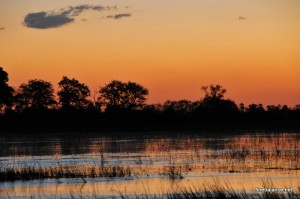 I was sitting snugly between my mother and Seejo while we were on our “night safari driveâ€.  It was pitch dark outside and I was lazily following the beam from the huge spotlight that Peter, our tracker, was  flashing from side to side. There was a slightly chilly breeze but I was wrapped up well with the warm blankets that the folks at Pom Pom camp had provided. The evening’s safari, thus far, had been rather disappointing.
I was sitting snugly between my mother and Seejo while we were on our “night safari driveâ€.  It was pitch dark outside and I was lazily following the beam from the huge spotlight that Peter, our tracker, was  flashing from side to side. There was a slightly chilly breeze but I was wrapped up well with the warm blankets that the folks at Pom Pom camp had provided. The evening’s safari, thus far, had been rather disappointing.
The Okavango Delta covers about 16,000 sq km and in that area there are only about 20-25 camps with each one accommodating about 20 odd guests.  Each camp, therefore, has its own private concession area where they can take their guests for a safari tour without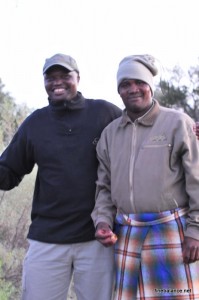 bumping into guests from other camps. For the tourists, it translates into a very personal safari experience where you do not have other vehicles waiting bumper to bumper to observe the same group of animals. But it also means that animals have a large area to move about freely.  In most cases, the sheer population of animals ensures that you will see many of them eventually but that evening they were proving to be particularly elusive.  Our guide, Shaku, had driven quite far away from the camp  that day so we had longer night drive than usual.  It was our last evening/night safari and I had hoped to see some of the wild creatures that we hadn’t seen so far but other than the ever present impalas , some kudus (large antelopes with a camel like hump and white stripes) and a horde of monkeys, we hadn’t come across anything else.
bumping into guests from other camps. For the tourists, it translates into a very personal safari experience where you do not have other vehicles waiting bumper to bumper to observe the same group of animals. But it also means that animals have a large area to move about freely.  In most cases, the sheer population of animals ensures that you will see many of them eventually but that evening they were proving to be particularly elusive.  Our guide, Shaku, had driven quite far away from the camp  that day so we had longer night drive than usual.  It was our last evening/night safari and I had hoped to see some of the wild creatures that we hadn’t seen so far but other than the ever present impalas , some kudus (large antelopes with a camel like hump and white stripes) and a horde of monkeys, we hadn’t come across anything else.
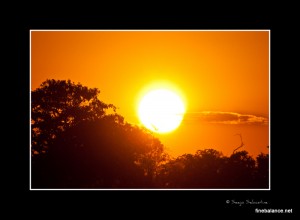 The night safari is a chance to see some of the nocturnal action that the delta offers. After sunset, the jungle turns into a very “happeningâ€place.  Most of the predators (especially the big cats) are active at night, the scavengers like the hyenas and jackals are creeping around trying to see if they can steal any leftovers from the bigger predators,  reptiles come out after sunset when the weather gets cooler and smaller nocturnal creatures such as mongoose and rabbits pop out to feed.  As I said, the activities really kick up a notch at night time.   Experienced guides can spot these animals because their eyes reflect and glow by the light of the flashlight that the tracker  aims into the night.  However, spotting creatures even during the day, when you can clearly see, is quite a challenge by itself, at night it is exponentially difficult.  I had developed a completely new appreciation for the natural camouflage that most animals seem to have , not to mention their ability to hide from their predators.   Although we had spotted some of the smaller animals and a few birds (owls) during our previousÂ
The night safari is a chance to see some of the nocturnal action that the delta offers. After sunset, the jungle turns into a very “happeningâ€place.  Most of the predators (especially the big cats) are active at night, the scavengers like the hyenas and jackals are creeping around trying to see if they can steal any leftovers from the bigger predators,  reptiles come out after sunset when the weather gets cooler and smaller nocturnal creatures such as mongoose and rabbits pop out to feed.  As I said, the activities really kick up a notch at night time.   Experienced guides can spot these animals because their eyes reflect and glow by the light of the flashlight that the tracker  aims into the night.  However, spotting creatures even during the day, when you can clearly see, is quite a challenge by itself, at night it is exponentially difficult.  I had developed a completely new appreciation for the natural camouflage that most animals seem to have , not to mention their ability to hide from their predators.   Although we had spotted some of the smaller animals and a few birds (owls) during our previous 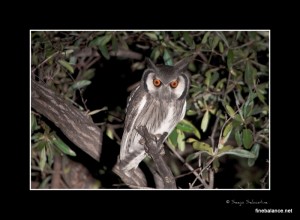 night drives, bigger game was more elusive and based on our last two night drives, I had no real hope of seeing anything.
night drives, bigger game was more elusive and based on our last two night drives, I had no real hope of seeing anything.
But then without any warning, Shaku slammed the brakes and brought the Land Rover to a sudden halt. I was on the verge of dozing off earlier but I was now instantly alert. By the headlight of the Land Rover and Peter’s flashlight, I saw what had caused it: there was a leopard right in front of our vehicle facing us.  As we watched, the leopard crouched low and started moving silently towards us. All of us immediately became very still as the leopard  quietly but very deliberately approached us and then at the last moment veered away and moved towards the right side of the vehicle. Shaku spoke softly  “ Don’t move, He is near the right side of the vehicleâ€, and then without any warning switched off all the lights.
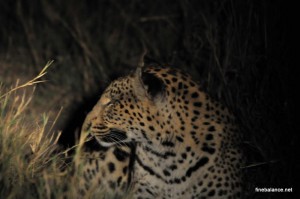 And that was when I started getting a little worried. There was a wild carnivore, with a known propensity and ability to climb trees coming towards us. We were in a Land Rover, open on the top and at the sides (the side panels of the Land Rover were only waist high), it was pitch dark: so dark that I could hardly see my own hands. And for some reason, our guide switched off all the lights leaving us very vulnerable and rather confused.
And that was when I started getting a little worried. There was a wild carnivore, with a known propensity and ability to climb trees coming towards us. We were in a Land Rover, open on the top and at the sides (the side panels of the Land Rover were only waist high), it was pitch dark: so dark that I could hardly see my own hands. And for some reason, our guide switched off all the lights leaving us very vulnerable and rather confused.
Shaku murmured an explanation “Did you see it was crouching, it is on a huntâ€. I am sure he was justifying the reason for switching off the lights but I confess that didn’t make me feel any better. But leopards are far more intelligent creatures than we give them credit for. It was really not interested in us as prey but it was not above using the vehicle as a cover. The leopard slowly crept towards the back of the vehicle and then ducked under it, behind the rear tires, to cross over to the other side of the path.  Although we could not see them with our poor night-vision skills, there were some impalas grazing on the other side and the clever leopard had managed to use our vehicle to get close to them without disclosing its location.
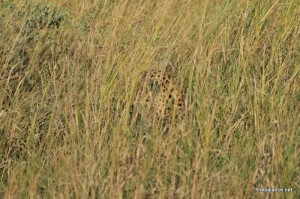 Our guides were experienced enough, so they quickly understood the situation. As soon as Shaku realized ( not sure exactly how he did it),that the leopard had crossed over, he quickly bought the Land Rover to life and swung towards the right and parked the car on the other side of the impalas. Again, we switched off the lights and waited in the dark for the leopard to make its move. We had seen a leopard (probably the same one) wait for its prey that every morning. It lay amidst the tall grass very peacefully and was so well camouflaged that Shaku almost drove into it. We were just a about a feet away from it with our Land Rover when one of the guests spotted it and yelled at Shaku to stop. Although it was in danger of being run over, the leopard didn’t move muscle or budge  from its hide out. Infact, the group of antelopes drinking water a few metres away were completely oblivious to the danger that lurked in the grass near them.
Our guides were experienced enough, so they quickly understood the situation. As soon as Shaku realized ( not sure exactly how he did it),that the leopard had crossed over, he quickly bought the Land Rover to life and swung towards the right and parked the car on the other side of the impalas. Again, we switched off the lights and waited in the dark for the leopard to make its move. We had seen a leopard (probably the same one) wait for its prey that every morning. It lay amidst the tall grass very peacefully and was so well camouflaged that Shaku almost drove into it. We were just a about a feet away from it with our Land Rover when one of the guests spotted it and yelled at Shaku to stop. Although it was in danger of being run over, the leopard didn’t move muscle or budge  from its hide out. Infact, the group of antelopes drinking water a few metres away were completely oblivious to the danger that lurked in the grass near them.
Given the leopard’s patience while hunting and its tendency to move very quietly, we had no idea how long it would take.  Waiting in the dark in the middle of a jungle was rather unnerving.  But the leopard didn’t make us wait too long. As soon as it leapt from its hiding place, the  impalas gave a cry of distress and started fleeing. The moment we heard the cry, Shaku switched on all the lights, Peter was ready with the spotlight and we were just in time to see the leopard catch an adult male impala. The rest of the herd was running helter-skelter but the leopard had a strong hold over the impala’sneck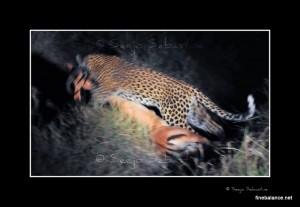 and was slowly but surely choking it to death. Every few minutes, the leopard would release its grasp slightly, almost as though to check if the prey were still alive. The impala would then writhe, trying to get away but the leopard was of course too strong. We were all slightly dazed at the sight in front of us, not sure whether to be exhilarated at the sight of the leopard’s skill or whether to feel sorry for the poor impala.  There was no other sound except the constant rat-a-tat as Seejo’s camera kept clicking away.
and was slowly but surely choking it to death. Every few minutes, the leopard would release its grasp slightly, almost as though to check if the prey were still alive. The impala would then writhe, trying to get away but the leopard was of course too strong. We were all slightly dazed at the sight in front of us, not sure whether to be exhilarated at the sight of the leopard’s skill or whether to feel sorry for the poor impala.  There was no other sound except the constant rat-a-tat as Seejo’s camera kept clicking away.
Within about 10 minutes, it was all over. The leopard then dragged the impala away into the
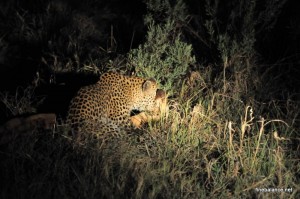
bushes. But all of us were very keyed up at seeing this extremely rare sight. We couldn’t stop marveling at how the leopard had leapt, how the impalas had scattered, the death choke of the leopard and how oblivious it was to our presence at the hunt. Shaku had already radioed our position to the other safari guide at Pom Pom and the other guests had arrived in time to see the leopard slink away into the bushes.
Our good fortune was commented on by everyone. Leopard sightings are uncommon but we had not only managed to see a leopard every time we went on the safari but now we topped it all by actually seeing a leopard hunt. Peter mentioned that this was his first leopard hunt,
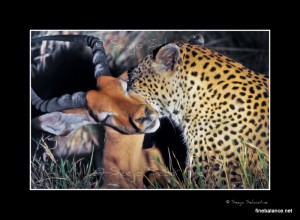
although he had been working at Pom Pom for over 4 years. Another guide asked us to leave our luck behind for them when we left. It was undoubtedly a stroke of good fortune to come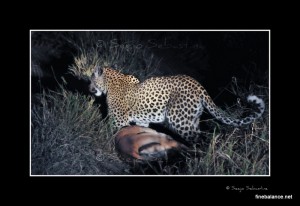 across the leopard but it was also the experience of Shaku who very cleverly recognized that the leopard was hunting, understood the location of the impala and then positioned the vehicle in such a way that we were right in the middle of the action.
across the leopard but it was also the experience of Shaku who very cleverly recognized that the leopard was hunting, understood the location of the impala and then positioned the vehicle in such a way that we were right in the middle of the action.
The next day morning, before we left Pom Pom , we stopped by at the scene of the crime to see if the leopard was still in the area. There was no evidence of the previous day’s hunt , not even a drop of blood.  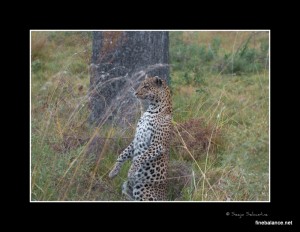 Shaku had to drive around a bit to spot the leopard but we finally saw it, lying quietly. At first glance, the impala was nowhere to be seen. We wondered whether he had lost his meal to the hyenas but then we saw that the leopard had cleverly hidden in below a nearby bush and then piled on some branches on it.
Shaku had to drive around a bit to spot the leopard but we finally saw it, lying quietly. At first glance, the impala was nowhere to be seen. We wondered whether he had lost his meal to the hyenas but then we saw that the leopard had cleverly hidden in below a nearby bush and then piled on some branches on it.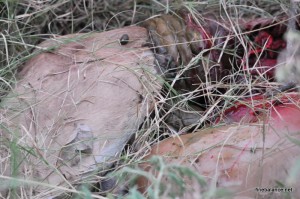 Periodically, it would rise, rocking back on its back legs and almost stand up to check its surroundings but most of the times it lay there peacefully storing its food to eat when hunger pangs strike again. Shaku told us that the impala would provide one adult leopard enough food for at least 3-4 days.  It was just a treat to see animals in action in their own surroundings and how they used it to its advantage in both capturing and storing its food.
Periodically, it would rise, rocking back on its back legs and almost stand up to check its surroundings but most of the times it lay there peacefully storing its food to eat when hunger pangs strike again. Shaku told us that the impala would provide one adult leopard enough food for at least 3-4 days.  It was just a treat to see animals in action in their own surroundings and how they used it to its advantage in both capturing and storing its food.

It was almost like reliving the hunt 🙂